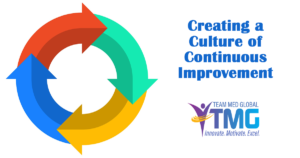 For Provider Lifecycle Professionals (PLPs), the work rarely slows down. Whether you’re managing credentialing files, navigating payer enrollment, tracking license renewals, or leading quality reviews, you’re constantly responding to deadlines, regulations, and evolving expectations. But amid the daily pressure to “get it done,” it’s easy to lose sight of something just as important: improving how it gets done.
For Provider Lifecycle Professionals (PLPs), the work rarely slows down. Whether you’re managing credentialing files, navigating payer enrollment, tracking license renewals, or leading quality reviews, you’re constantly responding to deadlines, regulations, and evolving expectations. But amid the daily pressure to “get it done,” it’s easy to lose sight of something just as important: improving how it gets done.
That’s where a culture of continuous improvement comes in. It’s not just a quality department buzzword but a mindset that belongs in every PLP function and across every healthcare environment.
What Is a Culture of Continuous Improvement?
At its core, continuous improvement means actively seeking ways to make processes more efficient, accurate, and responsive. But it’s more than a set of projects; it’s a culture where team members feel empowered to question outdated routines, propose solutions, and implement changes that make a real impact.
For PLPs, this means shifting from “task completion” to process ownership. It’s about asking:
- Why do we do it this way?
- Is there a better method?
- What’s getting in the way of better outcomes—for providers, patients, or our team?
Why It Matters in PLP Roles
PLPs work at the intersection of compliance, data, and human relationships. In that space, even small inefficiencies or breakdowns can have ripple effects across entire systems.
A culture of continuous improvement helps PLPs:
- Reduce credentialing and enrollment delays
- Prevent errors in license tracking or documentation
- Increase provider satisfaction with onboarding
- Improve internal communication and handoffs
- Strengthen audit-readiness across functions
It’s not about doing more. It’s about doing smarter.
What It Looks Like in Practice
Creating this culture doesn’t require a formal Lean Six Sigma program (though tools like that can help). It starts with small shifts in daily habits:
- Document pain points as they happen, then set time aside to review them.
- Invite input from across your team, not just leadership. The best ideas often come from those closest to the work.
- Pilot changes before committing to them; try it with one specialty, one payer, or one provider group.
- Track outcomes so you can see what’s working and what’s not.
Importantly, improvement efforts shouldn’t feel like an add-on. They should be part of your team’s regular workflow.
Leadership Support and Team Buy-In
To create a true culture of improvement, leadership must support experimentation and learning. But the effort also depends on team members who are willing to speak up, test ideas, and share insights.
Whether you’re a team lead or an individual contributor, you can foster that culture by:
- Asking thoughtful questions during team meetings
- Recognizing when a teammate improves a process
- Sharing small wins—and documenting what made them work
PLPs as Drivers of Progress
PLPs already play a vital role in ensuring healthcare operates smoothly. When they bring a mindset of continuous improvement to that work, they don’t just meet expectations—they raise the bar.
At TMG, we believe that every PLP has the power to lead change. If you’re ready to elevate how your team works, explore our courses and webinars. Progress starts with one question: How could this be better?

